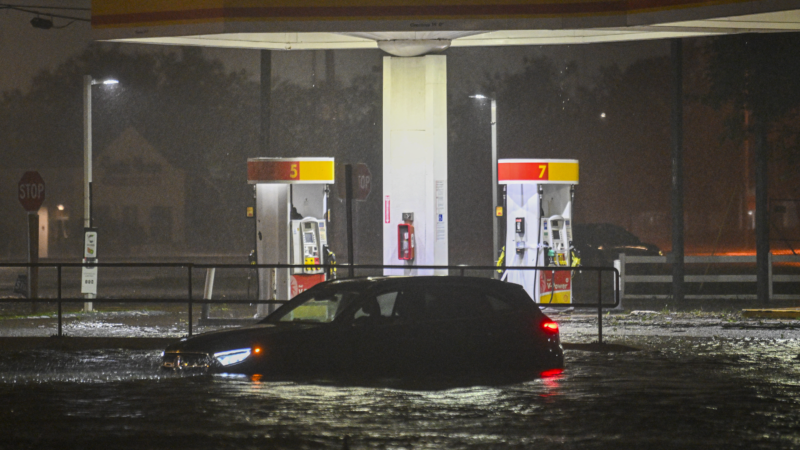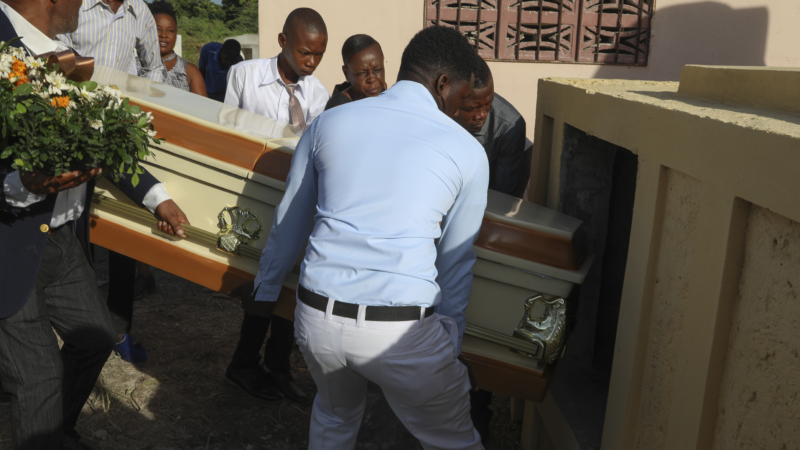These maps and images show what’s left of Gaza, 1 year into the Israel-Hamas war
Loading…
Within hours of Hamas’ attack on southern Israel on Oct. 7, 2023, Israel began airstrikes across the Gaza Strip. Last Oct. 27, Israel’s ground invasion of Gaza began, and within a few days the Israeli military had encircled Gaza City. In the months since then, the war in Gaza has continued unabated and has yielded one of the most devastating humanitarian crises in recent decades, as almost 2 million residents have fled the onslaught of bombardment, demolition and warfare.
Last year’s Oct. 7 Hamas-led attack killed around 1,200 people and about 250 individuals were taken hostage, according to Israeli authorities. Israel’s military response since then in Gaza has killed more than 42,000 Palestinians, according to Gaza’s Health Ministry. Risk of famine in Gaza is widespread.

The conflict has expanded: Hezbollah in Lebanon began firing rockets at Israel on Oct. 8, 2023, leading to Israeli-Hezbollah fighting that has intensified recently, and hostilities have drawn in Iran and militias in Yemen and Iraq. No cease-fire has been reached.
After a year of war, here is what’s left of the Gaza Strip.
Infrastructure damage
A year of Israeli airstrikes and demolitions has left Gaza in ruins. It’s estimated that nearly 60% of buildings in the enclave have been damaged or destroyed, according to satellite data analysis by Corey Scher of the City University of New York’s Graduate Center and Jamon Van Den Hoek of Oregon State University.
By the beginning of 2024, 71% of buildings in Gaza City and 67% of buildings in northern Gaza were already damaged or destroyed. This destruction then followed Israel’s campaign against Hamas as troops moved farther south, with Deir al-Balah, Khan Younis and finally Rafah seeing a steady increase in bombardments and Israeli clearing operations.
Loading…
The Israeli military says that it has struck more than 40,000 targets from the air, dismantling more than 1,000 rocket launchers and locating about 4,700 Hamas tunnel shafts as of Sept. 25.
The U.N. Office for the Coordination of Humanitarian Affairs reports that 87% of schools in Gaza have been hit by munitions or been damaged since the beginning of the conflict.
In May, Palestinian civil defense authorities estimated that as many as 10,000 people may be buried under rubble throughout the enclave. These people, presumed dead, are not included in the casualty numbers that Gaza’s Health Ministry publishes.
The more than 37 million metric tons of debris include over 800,000 metric tons of asbestos and 7,500 metric tons of unexploded ordnance, according to U.N. estimates.
Adding to the chaos, roads in Gaza are increasingly impassable. An analysis released by the United Nations Satellite Centre (UNOSAT) on Sept. 4 estimates that 68% of roads in Gaza have been damaged or destroyed, hampering the movement of millions of repeatedly displaced people, as well as ambulances and aid groups operating in the enclave.
Loading…
This damage includes demolition by the Israeli military along two strategic corridors, the Philadelphi Corridor adjacent to Egypt and the Netzarim Corridor bisecting the territory south of Gaza City.
Agricultural damage
Prior to the war, nearly a quarter of the land in Gaza was covered with orchards, crops or greenhouses, according to He Yin, head of the Remote Sensing and Land Science Lab at Kent State University.
Yin has been closely studying agriculture in the Gaza Strip over the past year. Olives, citrus fruits, flowers and vegetables once grew abundantly there. After a year of war, 70% of greenhouses and nearly 70% of tree crops have been damaged or destroyed, according to Yin’s analysis of high-resolution satellite imagery of the region. Tree crops include citrus fruits, olives and other orchard trees. They don’t include natural trees or shrubs.
Loading…
“Agriculture [in Gaza] is economically valuable, but it’s also a cultural symbol,” Yin says. Many Gaza residents have been forced to cut down their own olive and citrus trees to create firewood to bake bread and boil water.
Before this war, about 90% of farmers in Gaza worked less than a half acre of land, according to a 2017 report from the nonprofit American Near East Refugee Aid. Others had small home garden plots next to their homes. The loss of a single tree can be devastating.
Loading…
“No matter what kind of tree crop, it takes years before you have a harvest,” Yin says. “So even if the war stops tomorrow, there’s no way to recover these [trees].”
Likewise, the loss of greenhouses will be felt for years to come. Greenhouses typically produce higher-value crops, like seasonal market vegetables.
Humanitarian crisis
The widespread destruction of buildings, roads and agriculture exacerbates the desperate situation faced by people throughout Gaza.
The U.N. reports that 17 out of 36 hospitals in Gaza are partially functioning, while the remaining 19 are out of service, as of Oct. 2. Many local medical personnel have been killed, wounded or repeatedly displaced, making hospital operations increasingly difficult. In August, NPR reported that hundreds of children in need of medical treatment were not being allowed to evacuate the territory, recently leading to the deaths of at least nine children awaiting care.
With the war stretching south over the past year, very few places in Gaza designated by Israel as safe zones for Palestinian civilians remain, as Israel’s military puts more and more of the territory under evacuation orders and carries out attacks there.
This has forced many residents to flee to the narrow strip of coast in al-Mawasi, designated as a humanitarian zone by the Israeli military. Conditions in this area are increasingly overcrowded and unsanitary, as family after family aims to find a safe place to shelter from the Israeli invasion.
Loading…
But this area is not free from Israeli bombardments either. In September, an Israeli airstrike hit the humanitarian zone, killing at least 19 people. In July, 90 Palestinians were killed in al-Mawasi by an Israeli airstrike. In both cases, Israel’s military said it was targeting Hamas commanders.
Using just satellite imagery, Yin can sense the growing desperation in Gaza.
“First they settled areas that [were] pretty empty — no one’s managing that land,” Yin observed. “Just barren land and natural fields with shrubs.”
But as safety in Gaza became increasingly elusive, he noticed displaced people finally entering agricultural land.
“They have to, because there’s not enough space.”
Methodology
Damage analysis of the European Space Agency’s Copernicus Sentinel-1 satellite data by Corey Scher of CUNY Graduate Center and Jamon Van Den Hoek of Oregon State University. The road analysis is from UNOSAT’s comprehensive road damage assessment, published Sept. 4, 2024, using imagery collected on Aug. 18, 2024. Tree crop damage analysis by He Yin, Kent State University. The analysis uses 3-meter PlanetScope imagery, courtesy of Planet Labs PBC.
Before and after satellite imagery courtesy of Planet Labs PBC. The borders of the humanitarian zone in Gaza are from the Institute for the Study of War and the American Enterprise Institute’s Critical Threats Project. Building footprints from the World Settlement Footprint, 2019.
Aya Batrawy and Daniel Estrin contributed to this report. Preeti Aroon copy edited the story.
Taylor Lorenz leaves ‘Washington Post’ after rift with editors
Washington Post editors lost faith in former tech columnist Taylor Lorenz, who called President Biden a "war criminal" and initially misled them about it. She has launched a new digital magazine.
Tesla is expected to unveil a robotaxi tonight: 5 things to know
On Thursday night, Tesla is holding a splashy event it’s calling “We, Robot.” CEO Elon Musk says fully autonomous vehicles are key to Tesla’s future, and for years he has promised they are coming.
Some students are fighting to stay in college after the FAFSA delayed financial aid
Students had to make all kinds of decisions about college before knowing how much financial aid they would get. Now, many of them are scrambling to stay in school.
‘The Apprentice’ director talks about the film Donald Trump doesn’t want you to see
Ali Abbasi's new film The Apprentice shows ex-President Donald Trump's years as a real estate businessman under the tutelage of lawyer Roy Cohn. The film coincides with Trump seeking another term.
Millions without power as Milton churns across Florida
Florida residents are being encouraged to shelter in place, as hazards such as storm surges, tornadoes and high winds and flash flood warnings were extended into early Thursday morning.
The death toll in a gang attack on a Haitian town rises to at least 115
The attack on residents of Pont-Sondé on Oct. 3 was one of the biggest massacres that Haiti has seen in recent history. The U.N. had previously said that at least 70 people were killed.







